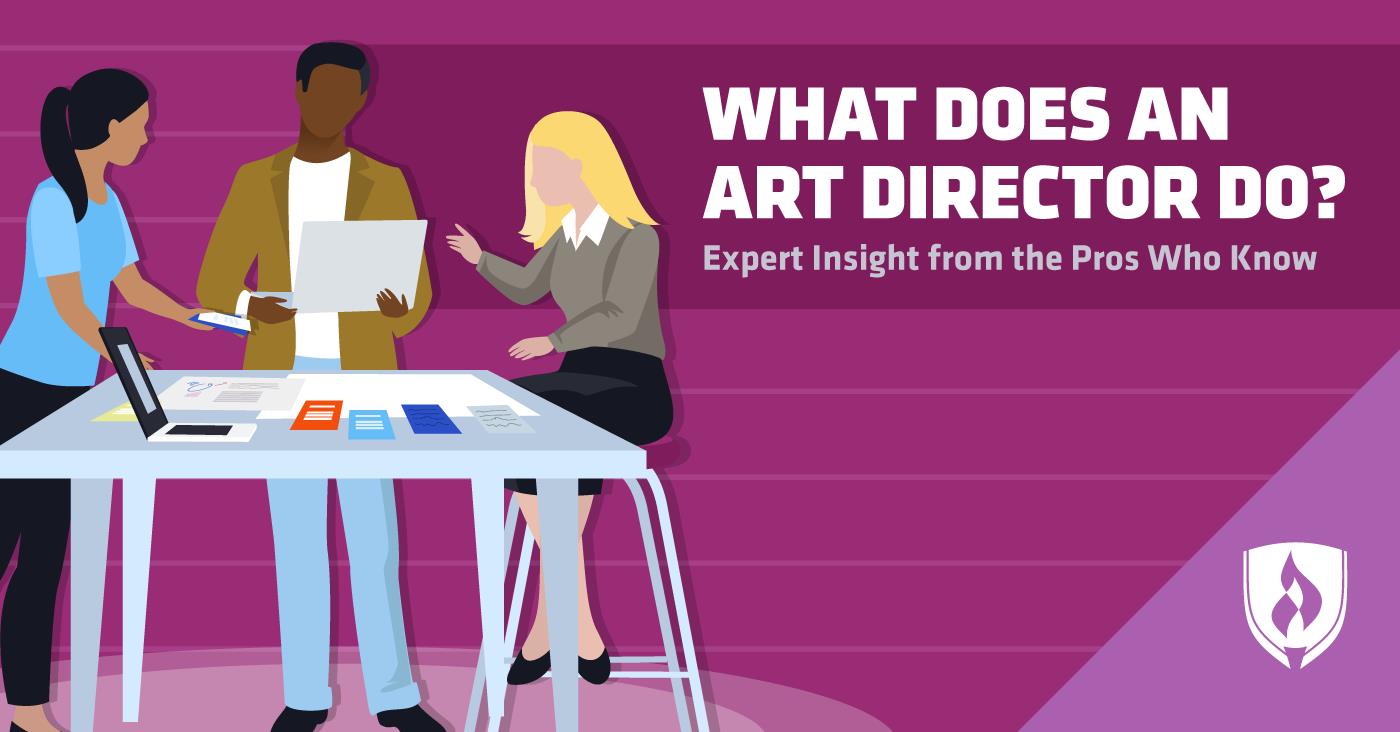
You’ve always had an eye for design, so no one was surprised when you started dabbling with putting your artistic side to work in a professional setting. Now that you’ve honed your skills and proven yourself a bit, you don’t want to be on the bottom of the totem pole forever.
The search for advancement opportunities has led you to an intriguing job title: art director. Being an art director sounds like a respected job that would allow you to build upon past experience as you move up in your career field. But what do art directors do all day? After all, you don’t want to blindly climb the professional ladder without knowing what you’ll be getting into.
First, you need to know whether the job you’re pursuing is the right fit for you. Go behind the scenes of an art director career with these insights from industry experts.
What do art directors do?
The heart of any art director’s work is to maintain a visual style for their organization, whether that’s a magazine, movie production or corporate brand. They find themselves in the unique position of being able to use both big-picture thinking to generate creative ideas as well as a detailed follow-up to keep a project headed in the right direction.
“As an art director in an advertising agency, my responsibilities are mainly in two areas: conceptualizing to come up with ideas for campaigns across various brands, and secondly, directing the art for those campaigns in every aspect,” says Marsha Chandy.
Art directors work closely with their design team to manage the look of projects from social media ad campaigns to in-store displays. It’s also their responsibility to make sure projects stick to a budget while meeting the client’s deadlines and specifications.
Where do art directors work?
Visuals make a huge impact on the way a brand is perceived, which makes art directors a valuable part of companies across many industries. Chandy notes that art directors have traditionally found a home working with ad agencies focused on the consumer goods or pharmaceutical industries, but the horizon is broadening for work opportunities.
“I would say any company that has a large enough media department will have an art director,” agrees Aaron Ripplinger, veteran art director and current director of strategic development at Design a Shirt. From the fashion and film industries to big tech companies like Google and Amazon, art directors can be found almost anywhere.
The versatility of an art director’s job can make this career a good option for anyone who craves variety. The Bureau of Labor Statistics (BLS) reports that a whopping 59 percent of art directors are self-employed. These design pros work with many different clients to help them achieve the right visual style. Another four percent work in the publishing industry, tackling tasks like creating magazine layouts or designing book covers, and 13 percent are in-house on advertising or PR teams.1
Whether you’d love to work for yourself or you prefer the stability of an in-house position, art directing is a career that offers you plenty of options in nearly any industry that piques your interest.
What are an art director’s job duties?
Art directors have to juggle a variety of responsibilities, so their day-to-day job duties can vary quite a bit. A freelance art director might find themselves meeting with creative team members, such as copywriters and photographers, to move forward in a project—or they might be working solo to create visuals themselves. “The art director either designs the various aspect of the ad themselves or works with an illustrator or photographer to art direct the ad and bring the idea to life,” Chandy says.
Art directors will typically also have a variety of managerial duties. “I spent my days managing workloads and approving the work done by my team. I would say my main duty was to ensure that we met deadlines in the most efficient manner possible,” Ripplinger says. “I also did a lot of work researching techniques and software that could make us more efficient.”
Whether an art director is doing hands-on design work, managing the details of a project or collaborating with their team, it’s their stamp of approval that gives every aspect of a project the green light. “The art director owns the creative vision of the ad and influences every artistic detail,” Chandy says.
What skills does an art director need?
Design skills are essential to this artistic career, but there’s more to art directing than just the visuals. These are some of the top skills that are needed to succeed as an art director, according to the U.S. Department of Labor:2
- CAD software
- Photo editing software
- Active listening
- Judgment and decision making
- Time management
- Complex problem solving
“The skill set being demanded of an art director these days only seems to be growing,” Chandy says. “One moment you may be a graphic designer. The next you may be a photographer. You'll need to know a little about certain things, and a lot about some other things.”
On the technical side, Chandy advises that most art directors should have a working knowledge of the Adobe® suite of creative software, as well as some familiarity with editing and animation programs.
Having plenty of people skills is also key for art directors. Collaborating with a team and working for clients means being able to manage others and accept constructive criticism for the good of the project. “You have to be able to take direction well, and be able to give direction even better,” Chandy says.
Design the next step in your creative career
Now that you know the answer to “What does an art director do?”, you might be thinking this artistic career sounds like a perfect fit for you to level up in your career. Learn more about how to climb the ladder to this exciting career with our article, “Becoming an Art Director: What You Need to Know.”
1Bureau of Labor Statistics, U.S. Department of Labor, Occupational Outlook Handbook, [information accessed August 6, 2018] www.bls.gov/ooh/. Information represents national, averaged data for the occupations listed and include workers at all levels of education and experience. Employment conditions in your area may vary.
2Bureau of Labor Statistics, U.S. Department of Labor, Occupational Employment Statistics, [information accessed August 6, 2018] www.bls.gov/oes/.




